Colonial Cunning Folk, part one: William Allison

A nondescript little notebook, hidden in plain sight in the state archives, has opened a window onto two extraordinary lives and yielded some startling insights into the popular beliefs and practice of traditional medicine in colonial Tasmania. William Allison (ca.1789-1856) and Benjamin Nokes (ca.1780?-1843) were ‘cunning men’, skilled in the use of herbal remedies, lacking formal qualifications but widely respected, operating somewhere on the spectrum between magic and science.
This post is about William Allison’s notebook, and what it reveals about his life and career. Our next post will explore the life of his co-practitioner Benjamin Nokes.
‘Almanac and notebook’ NS261/1/1
‘The past is a foreign country. They do things differently there.’ – L.P Hartley, The Go-between
My generation heard that line from so many history teachers that it lost its force, even much of its meaning. We also took as established fact – the way nuanced observations of cautious specialists are rendered down through text books and further simplified in school rooms – that the end of witch trials in the eighteenth century marked the end of widespread belief in witchcraft.
Until the chance discovery of traditional English magical markings in the stables at Shene, a historic property at Pontville, there was no suggestion that British folk magic had found its way to Van Diemen’s Land. Dr Ian Evans, an expert in preserving and restoring heritage houses, was visiting Shene when he noticed a hexafoil, or ‘daisy wheel’, a good luck symbol and protection against evil that can be traced back to at least the 6th century BC.
Further research by Evans and his team has since found ritual markings and evidence of other folk magic practices in colonial-era houses and outbuildings across Tasmania, and on the Australian mainland, persisting into the 1920s. But one of his most significant discoveries was not carved into a stone or hidden above a lintel. It was a nondescript little book, encased in a crude but sturdy leather pouch, which careful reading revealed to be the notebook of a ‘cunning man’, a practitioner of folk magic and dispenser of herbal remedies, active in Van Diemen’s Land in the 1830s.
![An old book open to the first page. Text reads: “Vox stellarum or, a loyal Almanack. For the year of human redemption. 1811, being the third after bissextile or leap-year, and the 51st of the reign of his present majesty. In which are contained all things fitting for such a work: as, a table of terms and their returns; the full changes, and quarters of the moon the rising, southing and setting of the seven stars; and other fixed stars of note; the moon’s age; and a tide table fitted to the same; the rising and setting of the sun; the rising, southing and setting if the moon; mutual aspects; monthly observations;; and many other things, useful and profitable. Unto which are added, astrological observations on the four quarters of the new years. A remarkable chronology; the eclipse and other matters both profitable and [illegible] observations on the weather and weather [illegible] and an hieroglyphic adapted to the times. By Francis Moore Physician. London. Printed for the company of stationers by William Thorne, red lion court, fleet street and sold by George Greenhill, at their hall in Endgate street. [price. Illegible]”](/wp-content/uploads/NS261-1-1_02-title-page-1024x757.jpg)
Almanacs are annual volumes of useful information. Vox Stellarum (‘the voice of the stars’) was one of the longest running and most popular, famous for its astrological predictions. At a time when sales of a few thousand made for ‘bestseller’ status, Vox Stellarum sold more than 100,000.
We are concerned here with a copy of the 1811 edition, bound with additional blank pages that were filled with notes by its original owner William Allison, who came to Van Diemen’s Land in 1828. It was given to the State Library of South Australia in 1970 by a donor who appears to have acquired it as a curiosity: there was no family connection with William Allison. Noting the Tasmanian content, the State Librarian forwarded it on to his Tasmanian counterpart.
William Allison was readily identifiable as the overseer at The Lawn, a property of some 2500 acres on the northern bank of the Derwent River between Bridgewater and New Norfolk. The property was owned by Arthur Davies, an officer in the Royal Navy. That was enough for cataloguing purposes. Allison’s book received a rudimentary description and became NS261/1, an unremarkable buff-paper parcel occupying a couple of centimetres of the many kilometres of records in the state archives.

No-one gave it another glance until Ian Evans’s careful reading transformed it instantly from one of the least significant items in the collection into one of the most. Copies of Vox Stellarum are commonplace. Personal diaries of cunning folk are extremely rare: Allison’s notebook is the only example currently known to have been written in colonial Australia.
What do we know about William Allison?
One of the difficulties in making definitive statements about ‘William Allison’ is that there were several of them in Van Diemen’s Land during the 1830s. The best documented is William Race Allison (1812-1865), who arrived in Hobart as a child. He became a major land owner near Campbell Town, and a member of Parliament. His age, and the circumstances of his arrival, eliminate him as a possible owner of the notebook.
Another William Allison, born around 1810, was transported in 1833 for stealing tools. Six months after arriving in Hobart he was assigned to The Lawn. He completed his sentence in 1839, and married in 1840; there is no definite record of him in Tasmania after that. None of these details match the internal evidence of the notebook. The William Allison we are looking for was at The Lawn three years earlier.
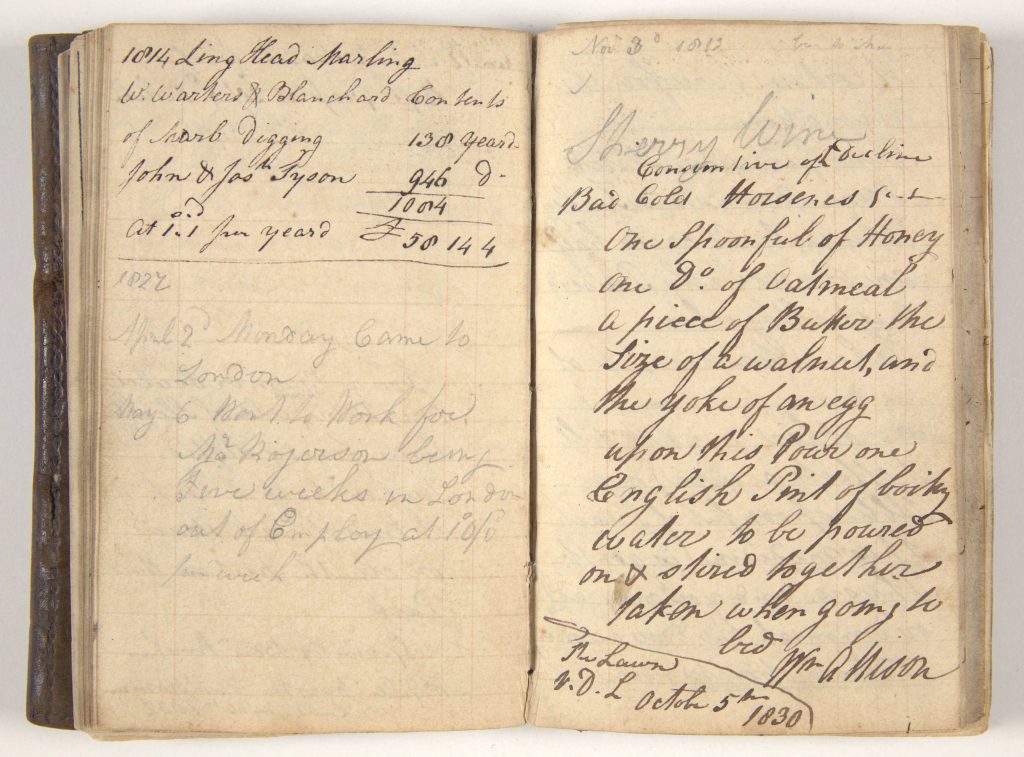
The William Allison of the notebook was also employed at The Lawn, from 1828 to 1832. He was born around 1789. The notebook shows that he spent most of the 1810s moving around eastern and north-eastern England: place names in the notebook range from Lincolnshire as far north as Durham. He settled in London in April 1822 and found work with a Mr Rogerson. In 1828 he entered into a contract to travel to Van Diemen’s Land with Lieutenant Arthur Davies, and work for him for four years. The notebook contains a brief diary of the voyage to Hobart.
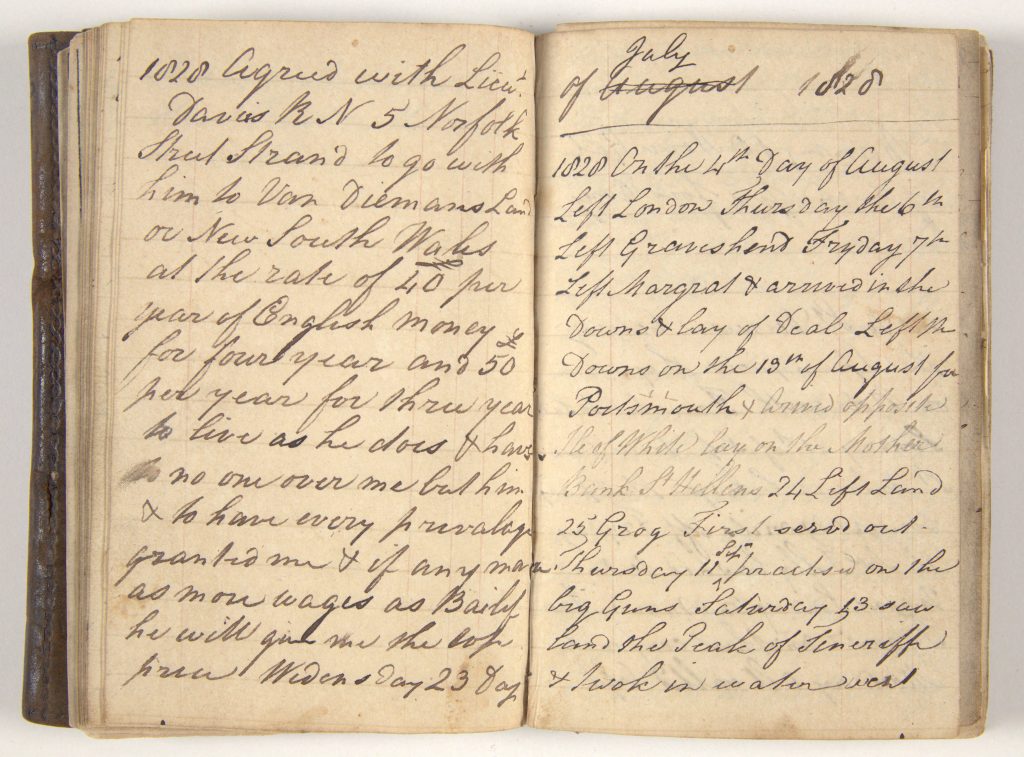
Allison’s contract with Davies expired in 1832, and he left The Lawn shortly before his namesake’s arrival. During 1832-33 he managed James Hobbs’s property at McGill’s Marshes, halfway between Oatlands and Little Swanport (Hobart Town Courier, 8 March 1833, p.1; Tasmanian, 20 December 1833, p.3). Allison attributes a recipe he was given there to ‘Benj Knokes’. Several other recipes are credited to ‘BN’. Benjamin Nokes will be the subject of our next post.
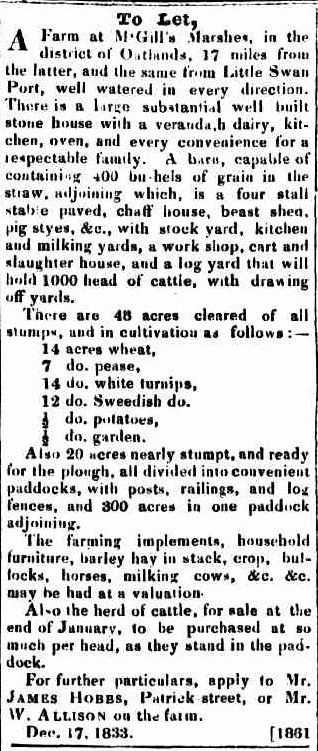
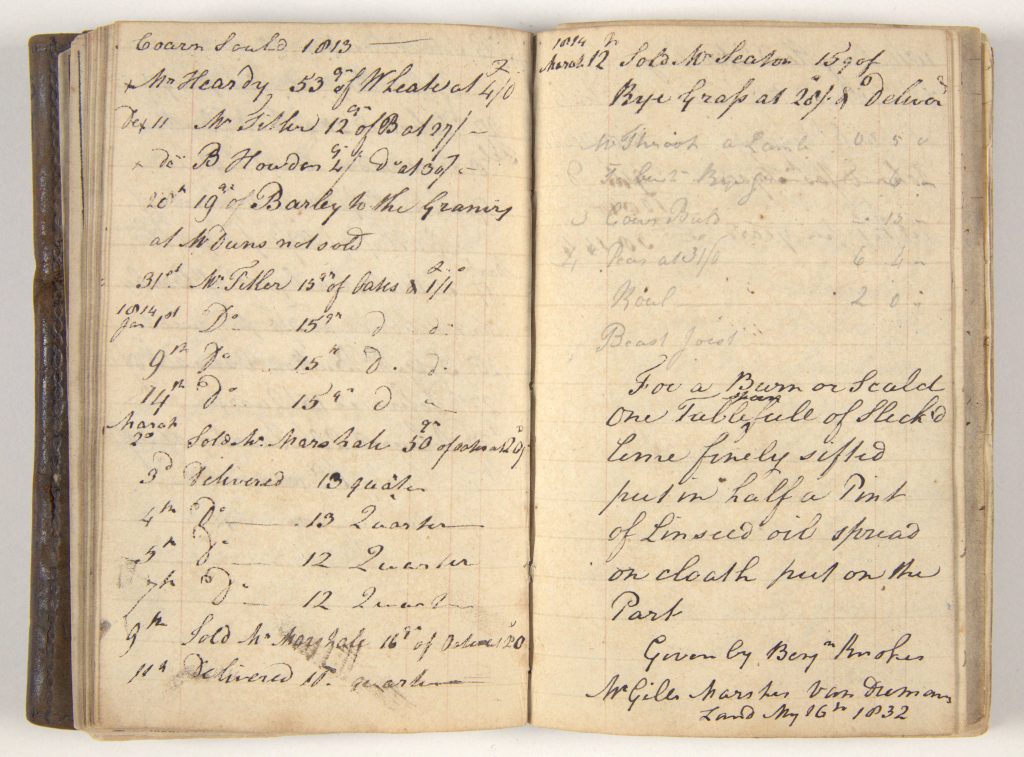
From 1845 until 1856 Allison was the licensee of the British Hotel in Liverpool Street, Hobart (Courier, 6 February 1845, p.3; 5 February 1856, p.5). This hotel, demolished in 1907, was between Argyle and Elizabeth Streets, now the site of the Wellington Centre.
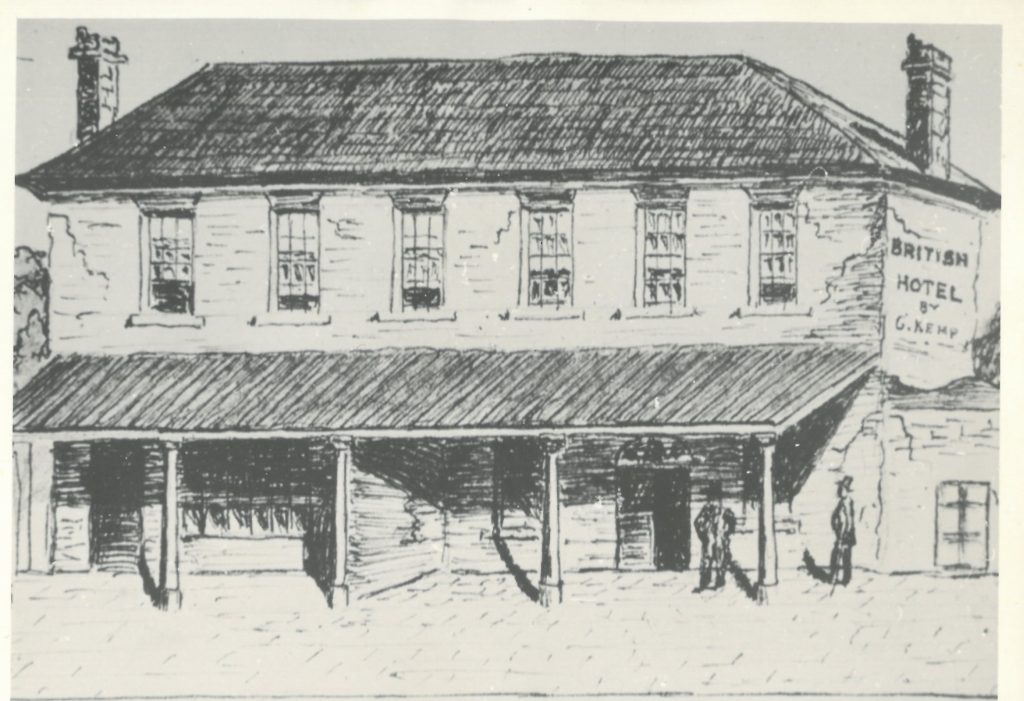
William Allison died in January 1856. An obituary described him as ‘honest, kind and benevolent … the complete English type in Tasmania of a country hotel-keeper, and will long be remembered in the community …like the good Samaritan, has often poured the “oil and the wine” upon others’ wounds’ (Courier, 9 January 1856, p.3). With the discovery of his notebook, these remarks can be read as cryptic references to his activities as a cunning man.
William Allison’s notebook has been digitised and can be viewed at https://libraries.tas.gov.au/Record/Archives/NS261-1-1.


who was the McGill for which the Mcgill marshes was named?
Hi Phil and thanks for your question. While I don’t know who McGill marshes was named after, I can help you to find out. Have a look in the first instance at our Guide to researching place names here: https://libraries.tas.gov.au/archive-heritage/guides-records/Pages/place-names.aspx You can also find information from the Placenames Tasmania website, run by the Department of Natural Resources and Environment: https://www.placenames.tas.gov.au/#p0 . And if you can’t find information quickly from either of those resources, please feel free to put in a research request, and we can do a little digging for you. You can do that here: https://www.libraries.tas.gov.au/get-help/Pages/help-finding.aspx I hope that helps!
Has anyone ever taken the almanac and typed out the handwriting? I am having the hardest time reading it.
Dear Dean,
Thanks for your interest. William Allison’s notebook is indeed a challenging document to decipher. It’s not just the handwriting, it’s the obscure words in the recipes and the lack of any obvious order. As far as we know no-one has ever made a typed copy of the complete text. Libraries Tasmania doesn’t have the resources to do that kind of work, we rely on volunteers. It would make a great project for somebody with an interest in the subject.
My great, great, great grandfather, John Martin, was the lessee of the British Hotel in Hobart from 1826 to 1831. He also held the lease of the Star and Garter Hotel in New Norfolk from 1827 to 1847. Is there any information about these 2 hotels available for viewing. Thank You.
Dear John, thanks so much for your comment. I’ve got a couple of suggestions for you. First of all, please have a look at our online guide to Hotels and Publican’s Licences, which you can find here: https://libraries.tas.gov.au/tasmanian-archives/guides-to-records/publicans-licences/introduction/ That will give you a good idea of what we have available online and what’s available in the library to view. Another option would be to file a reference request, and then one of our librarians or archivists can have a good look for you (for free!). We can spend up to an hour on each reference enquiry. If you’re interested, you can find the link to the form here: https://sltas.altarama.com/reft100.aspx?key=Research . Thanks again!